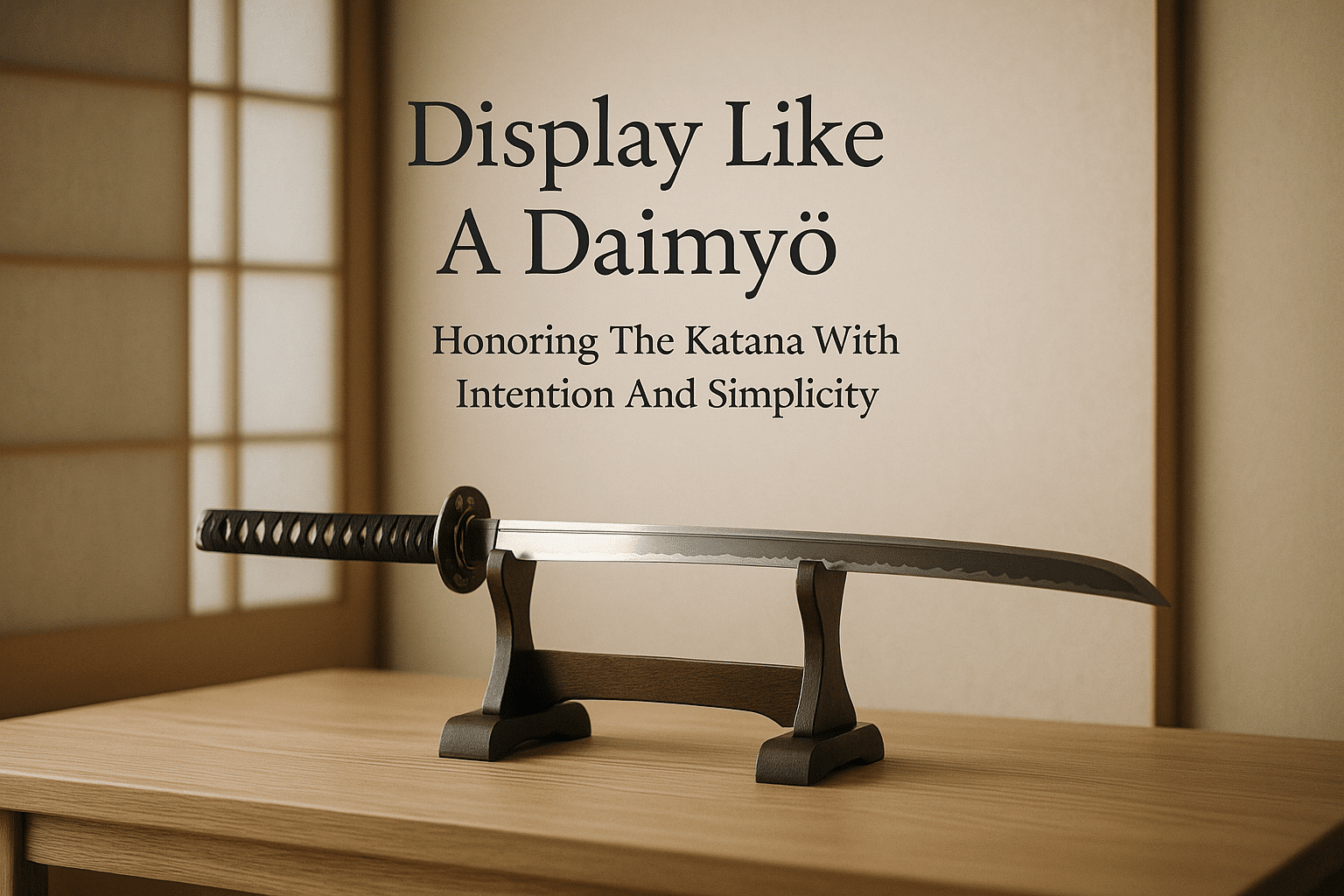Introduction: The Sword as Stillness
The katana is a blade born of fire, quenched in silence. It cuts not only with edge, but with purpose.
In the stillness of the dojo, it rests. Not drawn in haste. Not brandished in pride. It waits—clean, precise, present.
To hold a katana is to hold responsibility. It demands focus, not fury. Stillness, not chaos. Grace, not violence.
This is not a weapon of rage. It is a mirror. It reflects the one who holds it. Every motion, every breath, becomes visible in the steel.
When wielded with intention, the sword teaches stillness. It reveals that true power does not rush. The cut that matters is the one born of clarity.
This is the path of the blade—discipline over impulse, awareness over noise. The katana is stillness shaped into form. Let us begin there.
Respect the Blade: Setting Your Intention
The katana is more than a weapon. It is a symbol of honor, discipline, and spirit. Rooted in the traditions of the samurai, the blade was never drawn without purpose. It embodies the quiet focus of the dojo, where every action is deliberate.
Displaying a katana in your home carries weight. It is not decor—it is statement. Treat it with reverence. Choose a place free of noise and distraction. A clean wall. A simple stand. Nothing else is needed.
Before placing the blade, set your intention. Ask yourself why it belongs in your space. To inspire mindfulness? To honor craftsmanship? The reason must be clear. Just as the blade once served a purpose, so must its presence now.
Keep the area around it uncluttered. Dust it with care. Offer the attention it deserves. In this way, you echo the way of the sword—not merely with form, but with spirit.
Finding the Right Space: Harmony in Placement
A katana carries presence. Where you place it matters.
Choose a space with stillness. A room that breathes. Avoid areas crowded with furniture or noise. The katana rests best where the mind can settle.
Natural light is ideal—soft, indirect. Let the blade reflect warmth without glare. Artificial light should be quiet and steady. No harsh beams. No flicker.
Consider the wall. Simple. Unadorned. Let the katana stand alone or with minimal company. A scroll. A single piece of art. Nothing more.
Height matters. Eye level is balance. Too high, and it dominates. Too low, and it loses stature. Place it where it meets your gaze naturally.
The direction matters, too. A katana pointing inward speaks of peace. Handle to the right, blade up—traditional, respectful. Handle to the left speaks of readiness.
Honor the space around it. Dust often. Step lightly. Make this a place of pause.
In placement, find harmony. In harmony, find respect.
Wall Mounts, Stands, and Kake: Choosing Your Display Method
Selecting the right method to display a katana reflects both respect and intention. The mount or stand becomes part of the sword’s presence, shaping how it is seen and honored.
Wall Mounts
Wall mounts offer a clean, elevated look. They save space and present the blade as art. Horizontal mounts display the tsuka (handle) to the left—a tradition that signals the sword is at rest. Vertical mounts highlight the blade’s length and grace. Either style should ensure the blade’s edge faces upward, preserving sharpness and balance.
Stands (Katanakake)
A katanakake is the classic choice. Placed on shelves or on the floor in a dedicated space, the stand carries the sword with dignity. Single sword stands keep focus on one blade. Multi-tiered stands allow for display of katana, wakizashi, and tanto together—the daisho, symbol of a samurai’s soul. Like the wall mount, the tsuka typically faces left when at rest.
Kake (Traditional Racks)
Kake refers broadly to traditional support racks. More ornate versions might appear in formal rooms or dojos. Simpler versions, with clean wooden lines, reflect wabi-sabi—the beauty in quiet detail. A well-chosen kake honors the sword and the space around it.
Display is not decoration. It is practice. Each choice shapes the feeling in the room. It speaks to stillness, to readiness, to legacy.
Safety First: Securing Your Katana
A katana commands respect—even when it’s not in your hand. Mounting it safely is part of that discipline.
Choose a solid, dedicated stand. Wall mounts should be anchored into studs—never drywall alone. Horizontal display is traditional. Edge up, handle to the left. This honors the weapon and signals peace.
Place the mount away from direct sunlight. UV rays fade the saya and weaken fittings. Avoid heat vents or humidity. Wood swells, lacquer cracks, and steel can rust.
Clean the blade before mounting. A light coat of choji oil helps prevent corrosion. Never display a dirty katana. It disrespects the blade.
Ensure stability. The sword should rest fully on the mount, balanced and secure. No shifting, no sliding. If it’s loose, adjust. If unsure, consult a craftsman.
A secure display is more than safety—it reflects your care and your practice. Let the katana rest in quiet readiness.
Material Matters: Wood, Cloth, and Stone
Materials shape the presence of a katana display. Each one offers its own rhythm and respect.
Wood brings warmth and steadiness. Natural grains echo the blade’s tradition. Oak, cherry, or hinoki age well and provide dignified contrast. Avoid overly treated or painted woods—they distract from the sword’s quiet power.
Cloth adds softness and depth. Silk and cotton are most common. Silk suggests refinement. Cotton speaks plainly. Use colors sparingly. Neutrals lead the eye to steel. Avoid synthetic blends. They hold static and dust.
Stone offers weight and finality. It grounds the display. Granite and slate work best. Cool, dense, without fuss. But be mindful—hard surfaces test the blade’s care. Use liners or rests when placing the katana.
Balance these materials with purpose. Let the blade lead. Materials should support, never compete. Simplicity reveals strength.
Minimalism and Meaning: Styling Your Space
Minimalism is not emptiness. It’s intention. Each item in your space should earn its place.
Start with clean lines and open space. Let the katana breathe. It should be the focal point, not lost in noise.
Choose elements that complement, not compete. A single scroll with a kanji phrase. A smooth river stone placed nearby. A bonsai tree, pruned with care.
Natural light adds presence. Shadows give depth. Let them play across the blade.
If you add art, keep it simple. One piece. A sumi-e ink painting. A subtle nod to tradition and form.
Silence is a design choice too. Purposeful emptiness around the katana creates reverence. Like a pause between movements in a kata—it holds weight.
Everything in the space should tell the same story: discipline, respect, balance. The katana is not a decoration. It’s a statement.
Let your display speak without saying too much.
Care and Cleaning: Preserving the Craft
A katana is more than steel—it is spirit. To honor its presence, care must be regular and mindful.
Begin by cleaning the blade after each use. Even the oils from your skin can invite rust. Use a soft cloth and light pressure. Always wipe away from the edge.
Apply choji oil, a traditional blade preservative. A few drops go a long way. Spread it evenly with a lint-free cloth or rice paper. This creates a barrier against moisture.
Inspect the blade under good light. Look for blemishes, rust spots, or fingerprints. Address these gently, never scraping or scrubbing.
The scabbard, or saya, should stay dry inside. Never sheathe a wet or dirty blade. Moisture within can dull and stain over time.
The handle, or tsuka, houses wisdom in its layers. If the wrap loosens, have it repaired by a skilled craftsperson. Do not attempt it hastily.
Store your katana horizontally, edge up, in a place free from humidity and dust. Avoid direct sunlight, which may warp the wood or fade the wrapping.
Cleaning is not routine—it is ritual. A quiet practice that binds the warrior to the weapon. Treat it with care, and it will carry your spirit forward.
Closing Thought: Still Blade, Still Mind
A still blade does not boast. It simply waits, ready.
So too, the mind—quiet, disciplined, aware.
Walking through the display is more than watching steel and motion. It is a mirror. Each glint of metal, each form, reflects the posture of attention.
Grace comes not from force, but from control. Presence is found not in noise, but in silence.
Like a sword kept sharp through care, the mind is honed by intention.
In every kata, every still moment between movements, the practice remains the same.
Still blade. Still mind.
That is the art.





